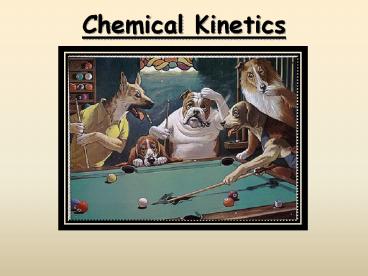Chemical Kinetics PowerPoint PPT Presentation
1 / 13
Title: Chemical Kinetics
1
Chemical Kinetics
2
CA Standards
Students know the rate of reaction is the decrease in concentration of reactants or the increase in concentration of products with time.
Students know how reaction rates depend on such factors as concentration, temperature, and pressure.
Students know the role a catalyst plays in increasing the reaction rate.
3
Collision Model
- Collisions must have enough energy to produce the
reaction (must equal or exceed the activation
energy). - Reactants must have proper orientation to allow
the formation of new bonds.
4
Activation Energy
The minimum energy required to transform
reactants into the activated complex (The
minimum energy required to produce an effective
collision)
Flame, spark, high temperature, radiation are all
sources of activation energy
5
Exothermic Processes
Processes in which energy is released as it
proceeds, and surroundings become warmer
Reactants ? Products energy
6
Endothermic Processes
Processes in which energy is absorbed as it
proceeds, and surroundings become colder
Reactants energy ? Products
7
2NO2(g) ? 2NO(g) O2(g)
Reaction Rates
1. Can measure disappearance of reactants
2. Can measure appearance of products
3. Are proportional stoichiometrically
8
The Reaction Mechanism
- The reaction mechanism is the series of steps by
which a chemical reaction occurs. - A chemical equation does not tell us how
reactants become products it is a summary of the
overall process.
Reactants ? Products
The ? sign has represents the reaction mechanism,
but gives no indication of the steps in the
mechanism
9
The Rate-Determining Step
- In a multi-step reaction, the slowest step is the
rate-determining step. It therefore determines
the rate of reaction.
10
Factors Affecting Rate
- Temperature
- Increasing temperature always increases the
rate of a reaction. - Surface Area
- Increasing surface area increases the rate of a
reaction - Concentration
- Increasing concentration USUALLY increases the
rate of a reaction - Presence of Catalysts
11
Catalysis
- Catalyst A substance that speeds up a reaction
by lowering activation energy - Enzyme A large molecule (usually a protein)
that catalyzes biological reactions. - Homogeneous catalyst Present in the same phase
as the reacting molecules. - Heterogeneous catalyst Present in a different
phase than the reacting molecules.
12
Endothermic Reaction w/Catalyst
13
Exothermic Reaction w/Catalyst

